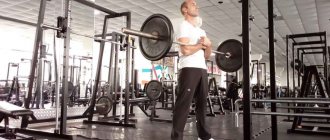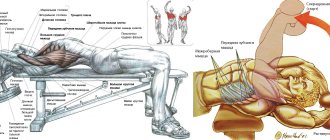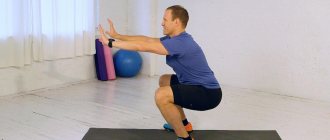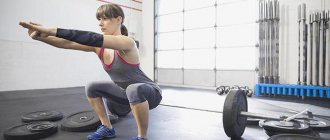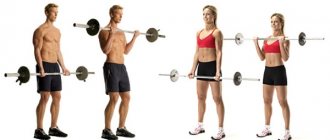Features of the Smith Squat
The peculiarity and great advantage of the exercise is that its technique allows you to avoid compressive load on the spine. Positioning your legs and positioning your torso at a slight angle allows you to shift the center of gravity and put maximum load on your legs. Unlike barbell squats, the Smith machine does not involve pushing part of the load out of the back and abdominal muscles. For many, this technique is much easier; this makes Smith squats accessible to girls or beginners who are not sufficiently prepared to work with free weights.
Benefits of Smith Machine Squats
- Distributes the load more on the muscles of the legs and buttocks, rather than on the back, allowing you to better work out the lower part of the body.
- Relieves the load from the spine, while the vertebrae are not subject to compression.
- Stabilizes body position and makes the technique more accurate, preventing unnecessary swinging and the help of other muscles, which can occur when working with a barbell.
- Different foot placement and bar position will help target the desired area of the hips.
- It is easier to monitor the depth of the squats in the simulator, and in Smith you cannot lose the barbell; when fatigue sets in, the bar can always be fixed at any level, minimizing the risk of injury.
Flaws
Many athletes believe that the disadvantage of squats in a machine is that the exercise does not sufficiently load the upper body, and unlike squats with a barbell, it does not give such a powerful anabolic boost, loading all large muscles.
Execution technique
The basic rule is not to bring your knees beyond the front line of your feet. You need to keep your back straight, squeezing your shoulder blades.
Types of lunges:
- forward;
- back;
- Bulgarian;
- oblique.
At home, you can exercise both with and without weights. The extra weight will help you achieve rounder buttocks faster.
Lunges forward
Squats with your body weight shifted forward are a classic option. From a smith position with a barbell on your shoulders, you need to step forward and shift your weight, the other leg remaining behind. Lunges with dumbbells for the buttocks in Smith are the most effective, while not causing injury. The classic version is performed with various weighting materials.
Fixed plane training uses fewer joints and muscles than free weights.
Reverse lunges or back lunges
This type of squat is done from the same position, only before starting the exercise the leg is moved back. It's best for beginners to start with back lunges with a lighter weight than usual, gradually increasing the load as they progress.
Due to the vertical movement of the barbell, the main load when performing some exercises falls on the shoulder joints.
Side lunges
In this type of exercise, the adductor muscles of the thigh and gluteus medius are loaded more. It is recommended that beginners do side lunges without weights to practice the technique. A little later they add weight.
Step-by-step technique of the side version:
- Stand straight with your feet next to each other.
- Move your leg to the side as far as possible.
- Bend your abducted leg at the knee to form a 90-degree angle.
- Do not bend the other leg, do not lift it off the floor.
- Lean your torso forward slightly as if you were squatting down.
- Return to step 1, pushing off with the heel of your working leg.
The Smith machine allows you to remove some of the stress from the joints and back, while working the muscles of the body.
Bulgarian lunges
Bulgarian lunges are a more complicated version, suitable for those who are more prepared. They differ from ordinary ones by using a bench or other elevation. Bulgarian squats help to train not only large target muscle groups, but also the stabilizing group due to the difficulty of maintaining balance.
Correct technique:
- Moving your leg back, place your toe on the prepared raised platform.
- Bend the leg you are leaning on slightly.
- Slowly descend as deep as possible.
- Make sure your knees do not lean forward too much. If necessary, abduct your leg further.
As progress is made, weights are added.
The effect on specific muscles directly depends on how the legs are positioned.
Cross lunges
Criss-cross glute lunges (curtsy or diagonal lunges) work the hip adductors well. As you progress, you can add cross lunges with a barbell or dumbbells.
Technically, it is carried out step by step according to the following points:
- Begin the exercise standing straight.
- One leg is brought back crosswise with the other to the maximum distance.
- At the same time, bend the leg on which you are leaning.
- Return to point 1.
Try squatting with an empty bar when you don't have at least a month of training under your belt.
Squat technique in Smith
This option allows you to load evenly all the muscles of the quadriceps and buttocks.
- Place the bar of the exercise machine on the upper part of the trapezoid, in no case on the neck , remove the bar from the locks. Hold the barbell with your palms wider than shoulder-width apart, elbows in the same plane as your torso.
- Place your feet a little further from the bar, taking small steps forward, with your body at an angle.
- As you inhale, slowly squat, move your pelvis back, stretching the muscles of your buttocks, and clearly fix your shins and knees at one point.
- When your pelvis reaches the same line as your knees, push your heels off the floor with an exhalation, loading your buttocks, and rise up.
- At the top point, do not move your pelvis forward, watch the position of your knees.
- After completing the exercise, lock the bar.
Smith squats with wide stance
In this option, the load is concentrated more on the adductor surface of the thigh, as well as on the buttocks.
- Place the bar below the neck vertebrae and remove it from the racks.
- Step back slightly from the barbell and place your feet wide, toes pointing out to the sides.
- As you inhale, move your pelvis back, squatting until it is parallel to the floor. Keep your knees and shins motionless.
- As you exhale, straighten your knees and straighten your torso.
Smith Squats with Narrow Leg Stance
This option works more on the abductor (outer) surface of the thighs and buttocks.
- Place the bar on the top of the traps and remove it.
- Step back a little and place your feet together.
- As you inhale, squat, moving your pelvis back, keeping your shins and knees motionless.
- Exhale, push through your heels and rise up, engaging your quadriceps and gluteal muscles.
Front Bar Smith Machine Squats
The option with a hyphae on the shoulders primarily loads the quadriceps and buttocks.
- Stand in front of the bar, placing it below your collarbones.
- Hold the bar with your palms slightly wider than shoulder-width apart, with an underhand grip, with your elbows pointing outward and upward, placing the bar on your front deltoids.
- Place your feet exactly under the bar across the width of your pelvis, parallel to each other.
- As you inhale, move your pelvis as far back as possible, squatting until it is parallel to the floor. The knees should not extend forward beyond the toes.
- Exhale and push your heels off the floor and straighten your torso.
You can also hold the bar on your shoulders with your arms crossed.
Learn more about front squats →
Split squat technique
Split squats or Bulgarian lunges work well all the gluteal muscles, thigh muscles and calves. In this case, one leg remains isolated, which helps to load additional groups to stabilize balance.
With dumbbells, disc in place
Step by step execution:
- Take weights and stand with your back to the stand.
- Place the abducted leg on the apparatus. This is the starting position.
- Bend your leg and squat down.
- Don’t slouch your back or arch your back, look straight.
In Smith
Exercises with a machine help relieve the stabilizing muscles due to the fixed movement of the barbell. Due to this, it becomes easier to control the entire process of training and the correctness of movements.
To perform the Bulgarian split, you need to prepare a bench or other elevated surface. Starting position - the abducted leg lies with the toe on the bench, the bar on the shoulders. From the starting position, slowly squat so that your supporting leg is bent to 90 degrees. The first movement is the pelvis stretches back.
Subtleties of the Smith split squat:
- take an acceptable weight, do not overload, adjust the bar as comfortably as possible;
- stand comfortably under the barbell, feet shoulder-width apart;
- bend your back slightly, look strictly straight;
- inhaling, lower yourself;
- exhaling, rise
Sets and reps
In order to properly load, decide on your training goals .
- If you need to increase muscle volume , perform 8-12 repetitions in 4 sets. Select the weight gradually; the load should not make it possible to squat for more than 12 repetitions. If you still have the strength to do a couple more reps, add weight. This technique is suitable for both men and women during the period of muscle building.
- To study the technique of the exercise, or for weight loss and when working on relief , perform 15-20 repetitions of 3-4 approaches. This training regimen increases the endurance of muscles and the whole body, and burns excess fat. Therefore, you need to select less weight to give the muscles the opportunity to perform a large number of repetitions.
The main advantages of the Smith machine
The exercise machine is a stationary platform that is fixed in a stable position and is used to perform a variety of strength exercises. It is very convenient to use this device for performing lunges and pull-ups. A barbell is attached to the platform, giving an even load on all muscle groups. Both girls and women, as well as men, can exercise with weights.
Men usually prefer lifting barbells, while girls enjoy doing lunges and exercises to strengthen the abdominal muscles. Experts say that lunges on the Smith are much easier to perform than on a standard step machine that is not equipped with weights. The only negative is that the device takes up a lot of space and is therefore not suitable for installation in small apartments.
Here are the main advantages of this simulator:
- The load is distributed evenly, the burden can vary.
- The machine can perform a wide range of exercises, aimed at athletes with different levels of basic training.
- The simulator is easy to learn, reliable and safe, it can be installed both at home and in gyms and health centers.
- Classes are highly effective because training promotes rapid correction of problem areas.
- The device can be used for daily training by both men (boys) and women (girls).
Common Mistakes
- Legs are in the wrong position. A common mistake is placing your feet under the bar when it is placed on your shoulders. This technique increases the load on the spine.
- The bar is located on the cervical spine or is too low on the shoulder blades. In the first case, the cervical vertebrae are injured, in the second, the joints of the shoulder girdle are overloaded.
- When extending the torso, the pelvis is pushed forward too much due to weakness of the abdominal muscles. In this case, there is a risk of injury to the lumbar spine.
- When squats, the knees move too far forward beyond the toes, injuring the joints and receiving excessive load.
special instructions
When performing the exercise, follow the following tips (true for both girls and boys):
- During the approach, inhale as deeply as possible. In this case, the inhalation should be done in a negative phase, when you lower, switching the load to the legs and buttock muscles. Exhale as you lift your torso;
- control your center of gravity, which can shift when performing lunges and you will lose your balance. The ideal option is to shift the center of gravity to the heel of the working leg. In this case, the foot should be completely on the floor (without lifting the toe);
- do lunges in the most comfortable sneakers (sneakers). The sole should be flat for better fixation with the flooring. Slippers and other “house” shoes are prohibited;
- Do not spread your knees to the side under any circumstances. It is important that the knee joint points in the same direction as the toe. In this case, the risk of injury will be minimal;
- change the order of legs from time to time (it is better to do this at each new lesson). This approach will avoid distortion, helping to evenly pump the muscles of the thighs and buttocks;
- try to use the exercise not as the main one, but as an auxiliary option (in addition to the main load for the legs and buttocks). In this case, you can achieve maximum effect;
- Avoid using too much weight, which increases the risk of injury.
How to focus on your quads or glutes
Despite the fact that the lunge exercise in the Smith machine duplicates the load of other lunges, for example, a farmer's gait with dumbbells, thanks to the fixation of the working weight and the position of the athlete, it is possible to emphasize the load on certain muscles.
- When setting your legs wide , when the leg is set far back, the main load comes to the gluteus maximus muscles.
- When placing your legs at medium length , when the legs are bent at the knees at a right angle, the main load falls on the quadriceps. With this positioning of the legs, the biceps femoris muscle also receives load, but to a lesser extent.
Common mistakes
Beginners should have an idea of the most common mistakes when performing this exercise so that they know what to look for first.
- One of the main mistakes is overestimating your strength and choosing the wrong barbell weights.
- Incorrect head position, looking at the floor or up.
- A shallow squat with a barbell that does not reach the end will be considered incorrect execution.
- The back is uneven.
- Bringing your knees together.
- Transferring weight to your toes.
Front squats are a good alternative to more popular exercises that reduce stress on the back and develop the quadriceps. You can choose several options for performing different projectiles, depending on your level of training and your own desire. It is important to follow the correct technique to avoid injury. First of all, experienced athletes who are ready to diversify their training should pay attention to the front squat.
Recommendations for implementation
When performing the exercise, follow some rules so as not to harm your health and ensure the greatest effectiveness for the body.
- It is important to observe yourself from the outside, standing in front of a mirror, especially at the initial stage. You can also ask someone to check the correct technique.
- It is worth carefully monitoring the position of your head. She should stand straight and look forward.
- To avoid problems with joints, the knees should not be extended at the top point. The load should be distributed to the leg muscles and not transferred to the knee joints.
- You need to squat smoothly, without sudden movements. The leg muscles are not fully engaged when performing jerks.
- It may not be possible to lift the same weight as when performing the classic version of the exercise. You need to start with a lighter weight.
- Clothing should be comfortable, not restrictive and not interfere with quality work with the barbell. It is better to give preference to non-slip materials. Choose shoes that are hard and have a small heel that won’t fall off your feet.
- It is important to monitor the position of your back. It should not be round, otherwise it will be extremely difficult to hold the barbell.
- You should not make long stops at the bottom point.
- To avoid dropping the bar, your elbows should be parallel to the floor; you should not bring them close to each other.
Precautions and contraindications
In some cases, performing lunges on Smith is contraindicated. Therefore, before starting training, it is recommended to consult with a general practitioner or (if you have problems with the spine) with a surgeon or orthopedist. So, any exercises with a barbell are contraindicated if a woman or girl has ever suffered a fracture of the pelvis or femoral neck.
Before you start exercising on the Smith machine at home, you need to check whether the device is securely installed and fixed on the floor. Under no circumstances should you start performing exercises if the platform is wobbly or in an unstable position. The bar must be strictly parallel to the floor, and the “pancakes” must be securely fixed on it.
Any exercises with a barbell, including lunges on a Smith machine, are strictly contraindicated for pregnant women at any stage of pregnancy, because strength training can lead to premature termination of pregnancy. Also, those who have recently undergone abdominal surgery (hernia removal, kidney stone removal, cesarean section) should not perform lunges. The load on the abdominal press can lead to spontaneous divergence of postoperative sutures , which can cause acute peritonitis - inflammation of the peritoneum.
Lunges on the Smith machine are strictly contraindicated for those who have problems with the spine. Also, this kind of exercise is not recommended for athletes with high myopia, because intense exercise can cause retinal detachment and subsequent complete or partial blindness. those who suffer from an inguinal hernia or have a testicular cyst should not lunge on Smith
